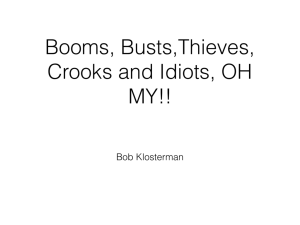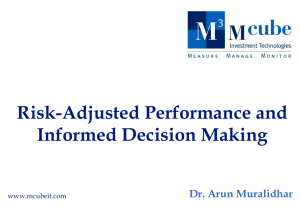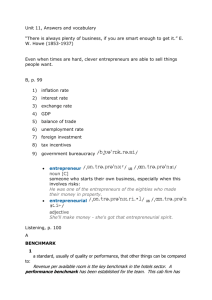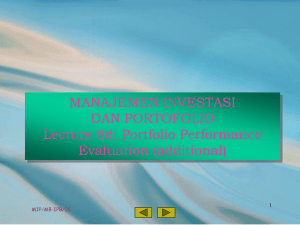Masters Thesis for Jason A Voss 1998_protected
advertisement
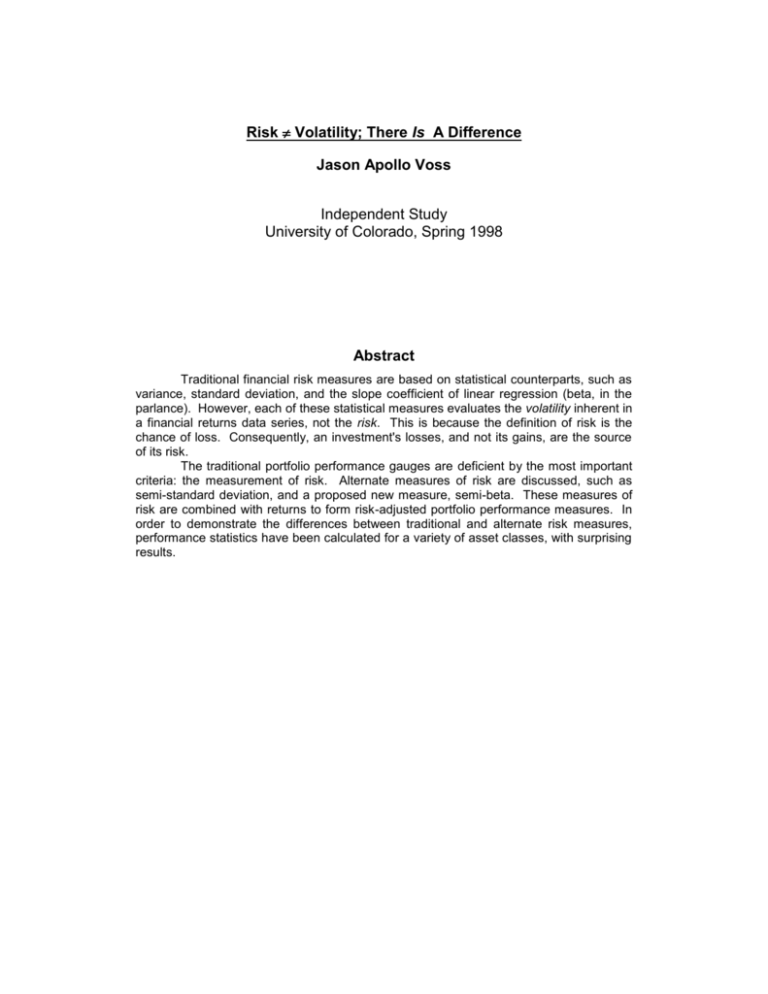
Risk Volatility; There Is A Difference Jason Apollo Voss Independent Study University of Colorado, Spring 1998 Abstract Traditional financial risk measures are based on statistical counterparts, such as variance, standard deviation, and the slope coefficient of linear regression (beta, in the parlance). However, each of these statistical measures evaluates the volatility inherent in a financial returns data series, not the risk. This is because the definition of risk is the chance of loss. Consequently, an investment's losses, and not its gains, are the source of its risk. The traditional portfolio performance gauges are deficient by the most important criteria: the measurement of risk. Alternate measures of risk are discussed, such as semi-standard deviation, and a proposed new measure, semi-beta. These measures of risk are combined with returns to form risk-adjusted portfolio performance measures. In order to demonstrate the differences between traditional and alternate risk measures, performance statistics have been calculated for a variety of asset classes, with surprising results. Risk Volatility; There Is A Difference Jason Apollo Voss Part I: Defining Risk Under the yoke of the efficient market hypothesis, investment companies and their portfolio managers have long suffered ridicule from academia. The academics claim that investors are better off placing money in investment portfolios chosen by blind monkeys throwing darts or into a passively managed index fund rather than placing savings into an actively managed mutual fund. This conclusion has always been drawn by comparing the risk-adjusted returns of portfolio managers with the riskadjusted returns of "the market." The author agrees that for appropriate comparisons to be made, one must use risk-adjusted returns to fully account for both risk premiums and the skill of the portfolio manager. Because calculating investment returns is straightforward, the analysis of investment companies versus efficient markets hinges critically on how risk is measured. Unfortunately, all of the popularly regarded risk standards fall short of fulfilling the duty of measuring risk. Agreement as to the definition of risk must be had before a discussion of the topic and evaluation of current risk standards can begin. Both Webster's, and the Oxford English Dictionary define risk as the chance of loss. Dictionary definitions and popular understandings of risk might differ from a business definition, yet a popular business dictionary describes over thirteen different forms of risk, ranging from exchange risk to unsystematic risk, all of which focus on the chance of loss. The insurance business is an industry critically dependent upon an understanding of risk, and an insurance licensing tutorial 1 says that "Risk means the same thing in insurance that it does in everyday language. Risk is the chance or uncertainty of loss." The traditional investment academe's definition of risk stands in stark contrast to popular understandings of risk. Almost unanimously, finance academics define risk as variability or volatility. A question frequently overlooked in academic discussions is why is portfolio evaluation important in the first place? The answer is to provide investors with better information about the additional performance added by a given portfolio manager or to evaluate the performance of a given set of investments. So, how would most investors define risk? Would they be concerned that their investment has returned more, on a risk-adjusted basis, than a benchmark index? Or would they be more concerned that their investment has returned less, on a risk-adjusted basis, than a benchmark index? Some investors equate risk with investment losses, not with investment gains (the notable exception being short sellers). Why, then, does academia define risk as volatility? The answer is that if financial risk is allowed to mean volatility then traditional statistics and its many models can be used without modification. That is, if a true definition of risk is used, hundreds of years of statistical theory cannot be used for financial analysis. The important question is whether or not statistical volatility is a valid proxy for risk. Part II: Traditional Volatility-Adjusted Portfolio Performance Measures The author assumes that the reader is familiar with the following measures, thus what follows is only a cursory discussion. Please refer to the appendix to see how each measure is formally calculated. 1 Life & Health Basics; Pictorial; Indianapolis, IN; 1991; p. 259 Risk Volatility; There Is A Difference Jason Apollo Voss The most basic investment risk measures are the variance (2) and its fraternal twin, the standard deviation (). These measures are no different from the and of statistics. The next basic measure of financial risk is or beta. The concept of was created by Sharpe as a part of his capital asset pricing model (CAPM). Both and provide the foundation for traditional risk adjusted return performance evaluation. Jack L. Treynor is responsible for the creation of the first composite risk-return measure of asset performance, known as the Treynor ratio (a.k.a. the Reward-to-Volatility Ratio). Very similar to the Treynor ratio is the Sharpe ratio (a.k.a. the Reward-to-Variability Ratio). The Jensen measure (a.k.a. or alpha) is related to both the Treynor ratio and the Sharpe ratio, in that it is also derived from the capital asset pricing model. Each of the traditional measures accounts for statistical volatility and not for risk. There is no provision in any of their calculations to distinguish between upside and downside performance. Ideally, risk measures should only take into account unsatisfactory results if they are to measure up to most investors' definition of risk. However, according to Sharpe, portfolio ranking results which make use of some sort of downside risk measure "will be the same if the probability distribution is symmetric, as is the normal distribution. Why? Because the left side of a symmetric distribution is a mirror image of the right side. Thus, a list of portfolios ordered on the basis of 'downside risk' will not differ from one ordered on the basis of standard deviation if returns are normally distributed." 2 Normal distribution is the issue to which we turn our attention next. Part III: Evidence That Some Asset Classes' Returns Are Non-Normal To determine whether or not money manager returns are normally distributed, Nelson's Marketplace database of money manager returns was utilized. The time period examined was the first quarter of 1987 to the second quarter of 1997 (42 quarters). A total of 2,216 money managers were examined. The money managers were divided by the predominant type of asset(s) held within the portfolio and were: non-U.S. balanced, non-U.S. derivatives/currency, non-U.S. equity, non-U.S. fixed income, U.S. balanced, U.S. derivatives/currency, U.S. equity, U.S. fixed income, and other. Eugene Fama's studentized range technique was applied to the database to determine if returns were normally distributed.3 The studentized range (SR) is calculated as: SR = Max( xi) - Min( xi) s(x) The SR value for each money manager is compared to a critical value and if the SR value exceeds the critical value then the returns are determined to be non-normal. 2 Sharpe, William F., Gordon J. Alexander & Jeffery V. Bailey; Investments: Fifth Edition; Prentice Hall; Englewood Cliffs, NJ; 1995; p. 177. 3 Fama, Eugene F.; Foundations of Finance: Portfolio Decisions and Securities Prices; Basic Books, Inc.; New York; 1976; pp. 3-38. Risk Volatility; There Is A Difference Jason Apollo Voss At the 95% significance level (critical value = 5.19) the returns for some of the asset classes were non normal. However at the 99% significance level (critical value = 5.586), all money managers had normally distributed returns. This means that the door cannot quite be shut on William Sharpe's argument. Two summary statistics for each asset class have been calculated. Namely, the average (arithmetic mean) SR for each asset class and the percentage of the money managers whose SR exceeded the critical value. The results for each asset class are displayed in exhibit 1. Exhibit 1: Money Managers With 42 Quarters of Data Studentized Range Results evaluated at the 95% and 99% significance levels Significance Level: 95% 99% Critical Value: 5.190 5.586 Money Manager Asset Type # of Type of % of Total # Avg. SR % >= Critical Value Mgr. 5.21 Non-U.S. Balanced Accounts 30 1.35% 50.00% 20.00% Non-U.S. Derivatives/Currency 9 0.41% 5.01 44.44% 22.22% 5.26 Non-U.S. Equity 206 9.30% 49.51% 27.67% Non-U.S. Fixed Income 68 3.07% 4.75 26.47% 4.41% 5.37 U.S. Balanced Accounts 345 15.57% 62.61% 35.07% U.S. Derivatives/Currency 6 0.27% 4.99 50.00% 16.67% 5.51 U.S. Equity 889 40.12% 72.33% 44.54% U.S. Fixed Income 636 28.70% 4.34 10.53% 5.66% 5.35 Other 27 1.22% 70.37% 40.74% Total: 2216 Weighted average studentized range: 5.10 Weighted average % of managers whose SR was >= critical value: 49.05% 28.56% There are a number of interesting results for this data set. First, where non-normality occurs, it seems to correspond with having an amount of equities in a portfolio. Second, the weighted average studentized range for all 2,216 money managers is only 5.10. Had all of the asset classes been considered together, rather than individually, the universe would have appeared normally distributed. Most importantly, the results show that there is potential for risk-adjusted portfolio performance measures to provide different information than that provided by traditional volatility-adjusted portfolio performance measures. A possible criticism of the data is that of survivorship bias. Nelson's Marketplace only includes the returns of money managers who have survived to the present. Part IV: Risk-Adjusted Portfolio Performance Measures This section reviews some of the existing methods of measuring the downside risk inherent in money manager returns. Further, several new techniques are developed, including a semi-Sharpe ratio, a semi-beta, and a semi-Treynor ratio. Critical to the assessment of portfolio risk is a measure that focuses only on negative returns. The semi-standard deviation (semi-) is such a measure. The calculation of the semi- is the same as Risk Volatility; There Is A Difference Jason Apollo Voss the calculation of the standard deviation (), except that the numbers used in the calculation only include periods during which the portfolio manager did not outperform an appropriate benchmark index. The recommended benchmark is the risk-free rate because it is a universal benchmark and can be used to measure both the risk of portfolio managers and of market benchmarks. This allows for direct comparisons between a manager's risk adjusted returns and a benchmark index's risk adjusted returns. Exhibit 2 provides a graphical example of what the semi- means.4 Exhibit 2: Graphical Illustration of Semi-Standard Deviation 40.0 30.0 Return as a Percentage 20.0 10.0 0.0 1986 1988 1990 1992 1994 1996 1998 -10.0 T-Bills -20.0 Apodaca Investment Group Upside -30.0 Quarter To calculate semi- the money manager returns below those of 90-day Treasury Bills are plugged into the regular standard deviation formula. In the above exhibit the appropriate returns for the semi- calculation are denoted by black triangles. Despite its strength as a risk measure, the semi- by itself is not a fully adequate measure of portfolio performance. To increase its validity, the semi- must be combined with an investment's returns to form a composite portfolio performance measure. The recommended method is to use semi- as the risk adjustment in the denominator of the Sharpe ratio, expressed mathematically as: Semi-Sharpe Ratio = Si = Ri - RFR semi - i The semi-Sharpe ratio eliminates many of the weaknesses of existing portfolio performance measures. Principally, it measures risk, and not volatility. The semi-standard deviation concept can be similarly applied to , whereby only those portfolio manager returns which lie below the return on a risk-free rate would be considered in calculating the 4 Apodaca Investment Group was selected randomly for inclusion with this study and is in no way affiliated with this research. Risk Volatility; There Is A Difference Jason Apollo Voss normal slope coefficient. This modified, semi- is then used as the denominator in the Treynor ratio as follows: Semi-Treynor Ratio = Ti = Ri - RFR semi - i The advantage of this measure is that it focuses on measurement of the systematic component of total risk rather than the total risk component. It also address the concern of some that portfolio managers rarely do manage all of the assets of an individual, which means that semi-standard deviation may be an inappropriate risk measure of portfolio management performance. When the semi-Treynor ratio is used in conjunction with the semi-Sharpe ratio, a better understanding of the risk-adjusted performance of a money manager is had than when traditional measures are used. Part V: An Analysis of Volatility-Adjusted Portfolio Performance Measures vs. Risk-Adjusted Portfolio Performance Measures Armed with a bevy of both volatility and risk measures it is now time to put each to the test by examining the performance of four separate asset classes. The asset classes considered are those from the 42 quarter sample that had the most observations. For each asset class, the author has chosen an appropriate benchmark index. U.S. equity managers are benchmarked against the Standard and Poors 500 Index (S&P 500); non-U.S. equity managers are benchmarked against the Morgan Stanley Europe, Australia, and Far East Index (MSCI EAFE); U.S. balanced managers are benchmarked against a composite index which is 50% S&P 500, 40% Lehman Brothers Aggregate Bond Index, and 10% 90-Day United States Treasury Bills (50/40/10); and U.S. fixed income managers are benchmarked against the Lehman Brothers Aggregate Bond Index (LB Agg.). The returns for both the index and the money managers are gross of fees and transactions costs. The results are summarized in exhibit 3 below. Risk Volatility; There Is A Difference Jason Apollo Voss Exhibit 3: Average Performance Statistics for Money Managers With 42 Quarters of Data: Alpha Beta Standard Deviation Annualized Excess Return Over T-Bills Sharpe Ratio Treynor Ratio Semi-Standard Deviation Semi-Beta Semi-Sharpe Ratio Semi-Treynor Ratio U.S. Non-U.S. U.S. U.S. Fixed Equity Equity Balanced Income S&P Avg. MSCI Avg. 50/40/10 Avg. LB Avg. 500 Mgr. EAFE Mgr. Mgr. Agg. Mgr. 0.00 0.04 0.00 1.33 0.00 0.02 0.00 0.15 1.00 0.98 1.00 0.65 1.00 1.07 1.00 0.77 14.24 16.18 17.45 17.02 7.71 9.26 5.05 4.69 10.95 0.77 10.95 15.32 1.00 0.72 10.95 10.51 0.68 11.38 13.74 0.88 0.77 11.90 4.02 0.23 4.02 14.41 1.00 0.28 4.02 7.54 0.47 15.60 13.65 0.57 0.55 13.15 6.89 0.89 6.89 6.82 1.00 1.01 6.89 7.35 0.82 7.13 7.54 1.05 0.97 7.01 3.05 0.60 3.05 2.65 1.00 1.15 3.05 2.93 0.76 6.82 2.86 0.74 1.02 3.99 The most interesting results are for the U.S. equity money managers who, by traditional volatilityadjusted portfolio performance measures, do not beat the market (S&P 500), but by the risk-adjusted portfolio performance measures, do beat the market. A careful look at the components of this result makes this conclusion even more surprising. The average annualized equity money manager's excess return over 90-Day U.S. Treasury Bills was 10.51%, while the market's was 10.95%. If a hypothetical equity investor looked purely at the returns, he would be well advised to invest in an index fund since the S&P 500 had higher excess returns. If the hypothetical investor is a little more sophisticated he will also compare the standard deviations for his two choices. Again, the market, with a of 14.24, would be a better choice than the average equity money manager, whose is 16.18. This sophisticated investor has no trouble in choosing the passively managed index fund by both traditional return and risk criteria. Yet, if the investor knows that standard deviation measures volatility and not risk, he looks at a measure such as the semi-Sharpe ratio to make a more informed decision. In this case, he chooses the average money manager over the passively managed index fund. Obviously this has implications for those who believe that investors are better off in an index fund, because the average money manager's risk-adjusted performance exceeds the market. Lest the reader think that risk-adjusted portfolio performance measures are a "magic bullet" which could be used to artificially improve the performance numbers of money managers, let us turn our attention to the other results. The risk-adjusted measures do not change the conclusions which would be drawn by traditional volatility adjusted measures for non-U.S. equity and U.S. balanced money managers. However, in the case of the average non-U.S. equity money manager, the risk-adjusted measures actually reduce (not improve) the magnitude by which the market is beaten. A similar story is told for both the U.S. balanced and U.S. fixed income money managers. The numbers in exhibit 4 demonstrate the point even more strongly. Using traditional volatilityadjusted portfolio performance measures, such as the Sharpe and Treynor ratios, less than half of the Risk Volatility; There Is A Difference Jason Apollo Voss U.S. equity money managers beat the market. Evaluation by risk-adjusted portfolio performance measures tells a different story. Around 60% of U.S. equity money managers beat the market according to the semi-Sharpe and semi-Treynor ratios. These results tell a previously untold empirical story, namely that the average money manager appears to focus on limiting losses and succeeds in doing so. Similar results were found for five other time periods (see Appendix B). Exhibit 4: Money Managers vs. Their Benchmark Index by Various Measures: First Quarter 1987 through Second Quarter 1997 Measure Sharpe Ratio Treynor Ratio Semi-Sharpe Ratio Semi-Treynor Ratio U.S. Equity (Compared to S&P 500) Benchmark Scores % of Managers Who Beat Benchmark 0.77 27.53% 10.95 44.83% 0.72 61.24% 10.95 58.88% Measure Sharpe Ratio Treynor Ratio Semi-Sharpe Ratio Semi-Treynor Ratio Non-U.S. Equity (Compared to MSCI EAFE) Benchmark Scores % of Managers Who Beat Benchmark 0.23 86.96% 4.02 92.27% 0.28 90.82% 4.02 91.79% Measure Sharpe Ratio Treynor Ratio Semi-Sharpe Ratio Semi-Treynor Ratio U.S. Balanced (Compared to 50/40/10) Benchmark Scores % of Managers Who Beat Benchmark 0.89 31.79% 6.89 45.66% 1.01 46.53% 6.89 51.45% U.S. Fixed Income (Compared to Lehman Brothers Aggregate Bond Index) Measure Benchmark Scores % of Managers Who Beat Benchmark Sharpe Ratio 0.60 57.30% Treynor Ratio 3.05 67.19% Semi-Sharpe Ratio 1.15 45.37% Semi-Treynor Ratio 3.05 58.24% Part VI: Conclusions In conclusion, risk is the chance of loss, and any historical asset or portfolio risk measure must therefore only consider the negative returns. Existing measures consider both good outcomes as well as bad. Consequently, they are measures of statistical volatility and not of risk. The returns of certain asset classes are non normal at the 95% significance level, yet at the 99% level they are normal. Thus risk measures which focus on bad outcomes may be appropriate for evaluating portfolio manager performance. Semi-standard deviation and semi-Beta are risk measures which consider only negative Risk Volatility; There Is A Difference Jason Apollo Voss outcomes and therefore are superior to existing measures in evaluating risk. When coupled with an investment's excess returns to form both the modified Sharpe and Treynor ratios, the semi-standard deviation and the semi-beta give a more accurate picture of the performance of money managers. The data suggest that money managers have long suffered under the yoke of the incorrect portfolio performance evaluation techniques. The average equity money manager (both U.S. and non-U.S.) beats the market as evaluated by the semi-Sharpe and semi-Treynor ratios. It remains to be seen if these results can be replicated with other data sets. For now, in the absence of a fully developed theory regarding the use of these measures, the author recommends they only be used to evaluate the performance of money managers who make use of equity assets. Risk Volatility; There Is A Difference Jason Apollo Voss Appendix A: Calculations Variance: (X - ) n - 1 2 = 2 Standard Deviation: = 2 Beta: ip = ( )( ) Ri - Ri Rp - Rp 2 M p Treynor Ratio: Ti = Ri - RFR i where: Ri = the annualized return for the money manager RFR = the annualized return for the risk free asset i = the slope coefficient of the manager relative to the benchmark index Sharpe Ratio: Si = Ri - RFR i where: Ri = the annualized return for the money manager RFR = the annualized return for the risk free asset i = the standard deviation of the money manager returns Jensen's Alpha: ri - rf = iM + (rM - rf) iM + Ui; where: ri = the expected return on security or portfolio i rf = the risk free interest rate iM = the intercept coefficient rM = the expected return on the market portfolio of risky assets iM = the systematic risk for security or portfolio i Ui; = the residual or error term Risk Volatility; There Is A Difference Jason Apollo Voss Appendix B: Money Managers vs. Their Benchmarks by Various Measures for Five Separate Time Periods Money Managers vs. Their Benchmark Index by Various Measures First Quarter 1987 through Second Quarter 1990 U.S. Equity (Compared to S&P 500) Measure Benchmark Scores % of Managers Who Beat Benchmark Sharpe Ratio 0.46 43.82% Treynor Ratio 8.64 48.09% Semi-Sharpe Ratio 0.35 60.00% Semi-Treynor Ratio 8.64 47.87% Non-U.S. Equity (Compared to MSCI EAFE) Measure Benchmark Scores % of Managers Who Beat Benchmark Sharpe Ratio 0.29 76.33% Treynor Ratio 6.64 84.06% Semi-Sharpe Ratio 0.43 61.35% Semi-Treynor Ratio 6.64 67.63% U.S. Balanced (Compared to 50/40/10) Measure Benchmark Scores % of Managers Who Beat Benchmark Sharpe Ratio 0.57 29.77% Treynor Ratio 5.17 34.39% Semi-Sharpe Ratio 0.50 43.06% Semi-Treynor Ratio 5.17 32.95% U.S. Fixed Income (Compared to Lehman Brothers Aggregate Bond Index) Measure Benchmark Scores % of Managers Who Beat Benchmark Sharpe Ratio 0.21 49.92% Treynor Ratio 1.21 51.49% Semi-Sharpe Ratio 0.38 43.01% Semi-Treynor Ratio 1.21 44.43% Money Managers vs. Their Benchmark Index by Various Measures Third Quarter 1990 through Fourth Quarter 1993 U.S. Equity (Compared to S&P 500) Measure Benchmark Scores % of Managers Who Beat Benchmark Sharpe Ratio 0.52 61.80% Treynor Ratio 6.79 71.01% Semi-Sharpe Ratio 0.51 73.15% Semi-Treynor Ratio 6.79 66.97% Non-U.S. Equity (Compared to MSCI EAFE) Measure Benchmark Scores % of Managers Who Beat Benchmark Sharpe Ratio (0.01) 86.47% Treynor Ratio (0.21) 85.99% Semi-Sharpe Ratio (0.01) 86.47% Semi-Treynor Ratio (0.21) 85.02% Risk Volatility; There Is A Difference Jason Apollo Voss Third Quarter 1990 through Fourth Quarter 1993 (Continued) U.S. Balanced (Compared to 50/40/10) Measure Benchmark Scores % of Managers Who Beat Benchmark Sharpe Ratio 0.83 55.78% Treynor Ratio 6.43 64.16% Semi-Sharpe Ratio 0.87 63.01% Semi-Treynor Ratio 6.43 55.49% U.S. Fixed Income (Compared to Lehman Brothers Aggregate Bond Index) Measure Benchmark Scores % of Managers Who Beat Benchmark Sharpe Ratio 1.59 55.26% Treynor Ratio 6.75 69.23% Semi-Sharpe Ratio 3.74 44.58% Semi-Treynor Ratio 6.75 45.05% Money Managers vs. Their Benchmark Index by Various Measures First Quarter 1994 through Second Quarter 1997 U.S. Equity (Compared to S&P 500) Measure Benchmark Scores % of Managers Who Beat Benchmark Sharpe Ratio 1.75 13.60% Treynor Ratio 17.73 27.42% 3.83 43.71% 17.73 44.61% Semi-Sharpe Ratio Semi-Treynor Ratio Non-U.S. Equity (Compared to MSCI EAFE) Measure Benchmark Scores % of Managers Who Beat Benchmark Sharpe Ratio 0.79 53.62% Treynor Ratio 5.77 68.12% Semi-Sharpe Ratio 3.15 24.15% Semi-Treynor Ratio 5.77 19.81% U.S. Balanced (Compared to 50/40/10) Measure Benchmark Scores % of Managers Who Beat Benchmark Sharpe Ratio 1.35 31.21% Treynor Ratio 9.11 44.22% Semi-Sharpe Ratio 2.49 64.45% Semi-Treynor Ratio 9.11 70.81% U.S. Fixed Income (Compared to Lehman Brothers Aggregate Bond Index) Measure Benchmark Scores % of Managers Who Beat Benchmark Sharpe Ratio 0.26 49.29% Treynor Ratio 1.30 49.45% Semi-Sharpe Ratio 0.49 45.68% Semi-Treynor Ratio 1.30 45.84% Risk Volatility; There Is A Difference Jason Apollo Voss Money Managers vs. Their Benchmark Index by Various Measures First Quarter 1987 through First Quarter 1992 U.S. Equity (Compared to S&P 500) Measure Benchmark Scores % of Managers Who Beat Benchmark Sharpe Ratio 0.40 52.02% Treynor Ratio 7.40 59.89% Semi-Sharpe Ratio 0.40 62.02% Semi-Treynor Ratio 7.40 61.57% Non-U.S. Equity (Compared to MSCI EAFE) Measure Benchmark Scores % of Managers Who Beat Benchmark Sharpe Ratio (0.01) 89.37% Treynor Ratio (0.33) 89.37% Semi-Sharpe Ratio (0.02) 89.37% Semi-Treynor Ratio (0.33) 85.02% U.S. Balanced (Compared to 50/40/10) Measure Benchmark Scores % of Managers Who Beat Benchmark Sharpe Ratio 0.54 39.88% Treynor Ratio 5.14 48.84% Semi-Sharpe Ratio 0.64 43.35% Semi-Treynor Ratio 5.14 46.53% U.S. Fixed Income (Compared to Lehman Brothers Aggregate Bond Index) Measure Benchmark Scores % of Managers Who Beat Benchmark Sharpe Ratio 0.51 53.69% Treynor Ratio 2.77 62.17% Semi-Sharpe Ratio 0.92 46.00% Semi-Treynor Ratio 2.77 52.75% Money Managers vs. Their Benchmark Index by Various Measures Second Quarter 1992 through Second Quarter 1997 U.S. Equity (Compared to S&P 500) Measure Benchmark Scores % of Managers Who Beat Benchmark Sharpe Ratio 1.70 16.18% Treynor Ratio 14.62 41.91% Semi-Sharpe Ratio 3.55 42.36% Semi-Treynor Ratio 14.62 50.90% Non-U.S. Equity (Compared to MSCI EAFE) Measure Benchmark Scores % of Managers Who Beat Benchmark Sharpe Ratio 0.98 52.17% Treynor Ratio 8.56 83.09% Semi-Sharpe Ratio 2.62 34.78% Semi-Treynor Ratio 8.56 31.40% Risk Volatility; There Is A Difference Jason Apollo Voss Second Quarter 1992 through Second Quarter 1997 (Continued) U.S. Balanced (Compared to 50/40/10) Measure Benchmark Scores % of Managers Who Beat Benchmark Sharpe Ratio 1.56 31.79% Treynor Ratio 8.67 51.45% Semi-Sharpe Ratio 2.37 72.25% Semi-Treynor Ratio 8.67 74.28% U.S. Fixed Income (Compared to Lehman Brothers Aggregate Bond Index) Measure Benchmark Scores % of Managers Who Beat Benchmark Sharpe Ratio 0.70 55.73% Treynor Ratio 3.34 64.68% Semi-Sharpe Ratio 1.39 54.79% Semi-Treynor Ratio 3.34 59.81% Risk Volatility; There Is A Difference Jason Apollo Voss References 1. Webster's Ninth New Collegiate Dictionary; Merriam-Webster, Inc.; Springfield, MA; 1989; p. 1018 2. The Compact Oxford English Dictionary: Second Edition; Clarendon Press; Oxford; 1991; p. 987 3. Friedman, Jack P.; Barron's Business Guides Dictionary of Business Terms, Second Edition; Barron's Educational Series, Inc.; Hauppage, NY; 1994; p. 530 4. Levy, Haim; Introduction to Investments; South-Western College Publishing; Cincinnati, OH; 1997; p. 192 5. Reilly, Frank K. and Keith C. Brown; Investment Analysis and Portfolio Management: Fifth Edition; The Dryden Press; Fort Worth, TX; 1997; p. 253 6. Brigham, Eugene F. and Louis C. Gapenski; Financial Management Theory and Practice: Eighth Edition; The Dryden Press; Forth Worth, TX; 1997, p. 145 7. Securities and Exchange Commission; "Improving Descriptions of Risk by Mutual Funds and Other Investment Companies"; 17CFR Parts 239, 270, 274; http://www.sec.gov/rules/concept/mfrisk.txt; printed 11/6/97; p. 6 of 26 8. Black, Ken; Business Statistics: Contemporary Decision Making; West Publishing Company; St. Paul, MN; 1994; p. 67 9. Kahn, Ronald N.; "Measuring Information Ratios"; BARRA Newsletter Winter 1996; http://www.barra.com/ResearchPub/BarraPub/mir-n.html; printed 8/15/97; p. 1 of 3 10. Grinblatt, Mark and Sheridan Titman; "Performance Evaluation: Finance Working Paper sponsored by Capital Management Services"; Anderson Graduate School of Management; University of California; Los Angeles, CA; February 5, 1992; p. 24
